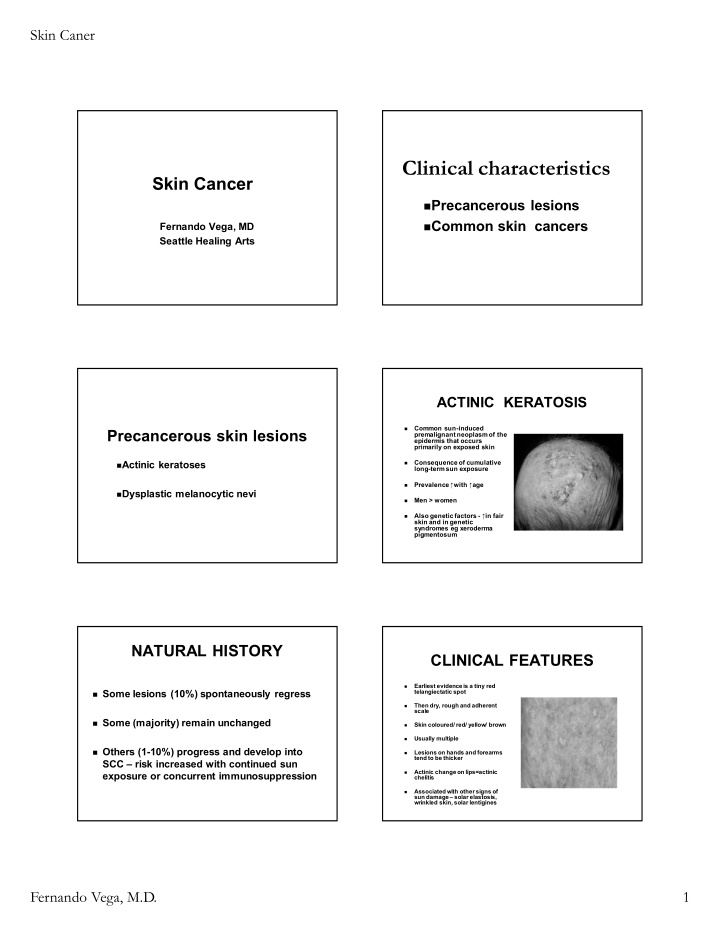



Skin Caner Clinical characteristics Skin Cancer � Precancerous lesions � Common skin cancers Fernando Vega, MD Seattle Healing Arts ACTINIC KERATOSIS Common sun-induced Precancerous skin lesions � premalignant neoplasm of the epidermis that occurs primarily on exposed skin � Actinic keratoses Consequence of cumulative � long-term sun exposure Prevalence ↑ with ↑ age � � Dysplastic melanocytic nevi Men > women � Also genetic factors - ↑ in fair � skin and in genetic syndromes eg xeroderma pigmentosum NATURAL HISTORY CLINICAL FEATURES Earliest evidence is a tiny red � � Some lesions (10%) spontaneously regress telangiectatic spot Then dry, rough and adherent � scale � Some (majority) remain unchanged Skin coloured/ red/ yellow/ brown � Usually multiple � � Others (1-10%) progress and develop into Lesions on hands and forearms � tend to be thicker SCC – risk increased with continued sun Actinic change on lips=actinic exposure or concurrent immunosuppression � chelitis Associated with other signs of � sun damage – solar elastosis, wrinkled skin, solar lentigines Fernando Vega, M.D. 1
Skin Caner Actinic keratoses Actinic keratoses Actinic keratoses and SCC Actinic keratoses and SCC Actinic keratoses Actinic keratoses and BCC 10% risk of malignant transformation Fernando Vega, M.D. 2
Skin Caner Hypertrophic AK ’ s Actinic cheilitis Liquid nitrogen Treatment of AK ’ s Cryotherapy Residual hypopigmentation � Liquid nitrogen cryotherapy � Topical therapies � 5-FU (Efudex) � Imiquimod (Aldara) � Curettage for hypertrophic lesions Blister formation Topical therapies Dysplastic nevi Efudex or Aldara * 3-5 times per week • Precursors for melanoma * 6-8 weeks • When to biopsy Fernando Vega, M.D. 3
Skin Caner Biologic Events and Molecular Changes in the Progression of Melanoma Clinical Images of Pigmented Lesions Miller A and M ihm M. N Engl J Med 2006;355:51-65 Tsao H et al. N Engl J Med 2004;351:998-1012 Risk factors for development of Non-melanoma skin cancers BCC and SCC � Fair skin (Fitzpatrick ’ s types I-III) � Blue eyes � Basal cell carcinoma � Red hair � Family history � Squamous cell carcinoma � Genetic syndromes � Keratoacanthoma � Chronic sun exposure � Old age � Arsenic, tar BCC- clinical types � Nodular Basal cell carcinoma � Superficial � Morpheaform Fernando Vega, M.D. 4
Skin Caner Nodular BCC � Chronic lesion � Easy bleeding � Pearly border � Surface telangiectasias � Head and neck, trunk, and extremities Fernando Vega, M.D. 5
Skin Caner Superficial BCC � Erythematous scaly plaque � Slow growth � Asymptomatic � Trunk, extremities, face Superficial BCC Morpheaform BCC � Resembles scar � Asymptomatic and slow growing � Ill-defined margins � Marked subclinical extension Treatment of BCC � BCC is the most frequent skin cancer � Curettage electrodessication (ED/C) (80%) � Surgical excision 95% Cure Rate � BCC is 4x more � Traditional frequent than SCC � Mohs surgery � Metastases are rare (<1% of cases) � Radiation therapy � Local destruction of 50-75% Cure Rate � Topical therapy tissue � imiquimod Fernando Vega, M.D. 6
Skin Caner SCC types � In-situ Squamous cell carcinoma � Bowen ’ s disease � Erythroplasia of Queyrat � Invasive SCC � Keratoacanthoma Bowen ’ s disease Invasive SCC � In-situ SCC � Erythematous nodule � Indurated lesion � Arsenic, HPV 16, radiation � Sun-exposed skin � Men > women � Slow growth Invasive SCC Keratoacanthoma � Low grade SCC � Rapid growth over weeks � Trauma, sun exposure, HPV 11 and 16 � May progress to invasive SCC Fernando Vega, M.D. 7
Skin Caner � SCC is locally invasive and destructive Malignant Melanoma � Metastases in 1-3% of cases � To lymph nodes � 50-73% survival � Distant sites (lungs) � Incurable Risk factors Clinical types- MM � Fair skin, red hair, and blue eyes � Intermittent sun exposure � Sunburns Superficial spreading melanoma � Tanning beds Lentigo maligna melanoma � Freckles and melanocytic nevi � Family history of melanoma Nodular melanoma Acral lentiginous melanoma Clinical Images of Pigmented Lesions ABCD of Melanoma � A symmetry � B order irregularity � C olor variegation � D iameter >6mm Tsao H et al. N Engl J Med 2004;351:998-1012 Fernando Vega, M.D. 8
Skin Caner Biologic Events and Molecular Changes in the Progression of Melanoma Miller A and M ihm M. N Engl J Med 2006;355:51-65 Benign Melanocytic Benign Melanocytic Neoplasms Neoplasms Benign Melanocytic Benign Melanocytic Neoplasms Neoplasms Congenital nevus Fernando Vega, M.D. 9
Skin Caner Malignant Melanoma Malignant Melanoma With Regression Malignant Melanoma Malignant Melanoma Supeerficial Spreading Malignant Melanoma Malignant Melanoma Ciliary Body Fernando Vega, M.D. 10
Skin Caner Malignant Melanoma Malignant Melanoma Malignant Melanoma Malignant Melanoma Malignant Melanoma Malignant Melanoma Fernando Vega, M.D. 11
Skin Caner Malignant Melanoma Malignant Melanoma Malignant Melanoma Malignant Melanoma Malignant Melanoma LENTIGO MALIGNA � An in situ pattern of malignant melanoma � Often reaches a large size before the diagnosis is made � Lentigo → lentigo maligna → lentigo maligna melanoma Fernando Vega, M.D. 12
Skin Caner MANAGEMENT CLINICAL FEATURES � Surgery – excision with a wide margin � Begins as a flat pigmented lesion � Radiotherapy � Usually on sun- exposed skin of head � Cryotherapy (deviation from rule) and neck � With time the colour � Immiquimod (by report) and border become more irregular Prognostic features- MM � Good prognosis � Breslow < 1mm � Intermediate prognosis � Breslow 1-4mm � Bad prognosis � Breslow >4mm Fernando Vega, M.D. 13
Recommend
More recommend